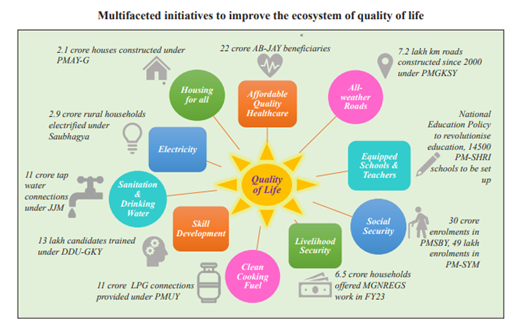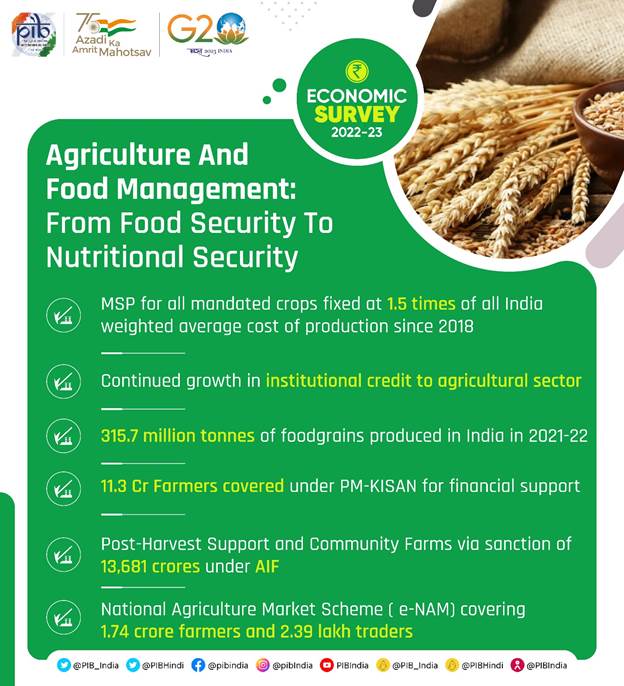
- Self-Study Guided Program o Notes o Tests o Videos o Action Plan

The thrust of the Government on rural development is discernable from the emphasis it gets in the Economic Survey 2022-23 tabled by the Union Minister for Finance and Corporate Affairs Smt Nirmala Sitharaman in Parliament today.
The Survey notes that 65 per cent (2021 data) of the country’s population lives in the rural areas and 47 per cent of the population is dependent on agriculture for livelihood. Thus, the focus of the government on rural development is imperative. The Government’s emphasis has been on improving the quality of life in rural areas to ensure more equitable and inclusive development. The aim of engagement of the government in the rural economy has been “transforming lives and livelihoods through proactive socio-economic inclusion, integration, and empowerment of rural India.”
The Survey refers to the National Family Health Survey data for 2019-21 which illustrates a significant improvement vis-à-vis 2015-16 in an array of indicators concerning the quality of rural lives, including, inter alia, access to electricity, presence of improved drinking water sources, coverage under health insurance schemes, etc. Women empowerment has also gained momentum, with visible progress in female participation in household decision-making, owning bank accounts, and use of mobile phones. Most of the indicators concerning the health of rural women and children have improved. These outcome-oriented statistics establish tangible medium-run progress in rural living standards, aided by the policy focus on basic amenities and efficient programme implementation.

Source: Economic Survey 2022-23
The Survey notes a multi-pronged approach to raise the rural incomes and quality of life through different schemes.
Rural women are at the core of the program which is extensively focused on their socio-economic empowerment. Nearly 4 lakh Self Help Group (SHG) members have been trained as Community Resource Persons (CRPs) (viz. Pashu Sakhi, Krishi Sakhi, Bank Sakhi, Bima Sakhi, Poshan Sakhi etc.) help in the implementation of the Mission at the ground level. The Mission has mobilised a total of 8.7 crore women from poor and vulnerable communities into 81 lakh SHGs.
Women’s economic SHGs have a positive, statistically significant effect on women’s economic, social, and political empowerment, with positive effects on empowerment achieved through various pathways such as familiarity with handling money, financial decision-making, improved social networks, asset ownership and livelihood diversification.
According to a recent assessment of DAY-National Rural Livelihood Mission, both participants and functionaries perceived high impacts of the programme in areas related to women empowerment, self-esteem enhancement, personality development, reduced social evils; and additionally, medium impacts in terms of better education, higher participation in village institutions and better access to government schemes.
During Covid, SHGs were in action mobilising women to unite, transcend their group identity and collectively contribute to crisis management. They emerged as pivotal players in crisis management, leading from the front in - producing masks, sanitisers, and protective gear, creating awareness about the pandemic, delivering essential goods, running community kitchens, supporting farm livelihoods etc. The production of masks by SHGs has been a noteworthy contribution, enabling access to and use of masks by communities in remote rural areas and providing vital protection against the Covid-19 virus. As on 4 January 2023, more than 16.9 crore masks were produced by SHGs under DAY-NRLM.
The Government rolled out “Housing for All by 2022” to provide shelter with dignity for each and every one. With this target, the Pradhan Mantri Awaas Yojana –Gramin (PMAY-G) was launched in November 2016 with the aim of providing around 3 crore pucca houses with basic amenities to all eligible houseless households living in kutcha and dilapidated houses in rural areas by 2024. Under the scheme, landless beneficiaries are accorded the highest priority in the allotment of houses. A total of 2.7 crore houses have been sanctioned and 2.1 crore houses have been completed by 6 January 2023 under the Scheme. Against the total target of completion of 52.8 lakh houses in FY23, 32.4 lakh houses have been completed.
The release of 9.5 crore LPG connections under the Pradhan Mantri Ujjwala Yojana, has helped in increasing the LPG coverage from 62 per cent (on 1 May 2016) to 99.8 per cent (on 1 April 2021). The Union Budget for FY22, made a provision for the release of an additional one crore LPG connections under the PMUY scheme, i.e., Ujjwala 2.0 - this scheme will offer deposit-free LPG connection, first refill and hot plate free of cost to beneficiaries, and a simplified enrolment procedure. In this phase, a special facility has been given to migrant families. Under this Ujjwala 2.0 scheme, 1.6 crore connections have been released until 24 November 2022.

***
RM/NR/KAK
The thrust of the Government on rural development is discernable from the emphasis it gets in the Economic Survey 2022-23 tabled by the Union Minister for Finance and Corporate Affairs Smt Nirmala Sitharaman in Parliament today.
The Survey notes that 65 per cent (2021 data) of the country’s population lives in the rural areas and 47 per cent of the population is dependent on agriculture for livelihood. Thus, the focus of the government on rural development is imperative. The Government’s emphasis has been on improving the quality of life in rural areas to ensure more equitable and inclusive development. The aim of engagement of the government in the rural economy has been “transforming lives and livelihoods through proactive socio-economic inclusion, integration, and empowerment of rural India.”
The Survey refers to the National Family Health Survey data for 2019-21 which illustrates a significant improvement vis-à-vis 2015-16 in an array of indicators concerning the quality of rural lives, including, inter alia, access to electricity, presence of improved drinking water sources, coverage under health insurance schemes, etc. Women empowerment has also gained momentum, with visible progress in female participation in household decision-making, owning bank accounts, and use of mobile phones. Most of the indicators concerning the health of rural women and children have improved. These outcome-oriented statistics establish tangible medium-run progress in rural living standards, aided by the policy focus on basic amenities and efficient programme implementation.

Source: Economic Survey 2022-23
The Survey notes a multi-pronged approach to raise the rural incomes and quality of life through different schemes.
Rural women are at the core of the program which is extensively focused on their socio-economic empowerment. Nearly 4 lakh Self Help Group (SHG) members have been trained as Community Resource Persons (CRPs) (viz. Pashu Sakhi, Krishi Sakhi, Bank Sakhi, Bima Sakhi, Poshan Sakhi etc.) help in the implementation of the Mission at the ground level. The Mission has mobilised a total of 8.7 crore women from poor and vulnerable communities into 81 lakh SHGs.
Women’s economic SHGs have a positive, statistically significant effect on women’s economic, social, and political empowerment, with positive effects on empowerment achieved through various pathways such as familiarity with handling money, financial decision-making, improved social networks, asset ownership and livelihood diversification.
According to a recent assessment of DAY-National Rural Livelihood Mission, both participants and functionaries perceived high impacts of the programme in areas related to women empowerment, self-esteem enhancement, personality development, reduced social evils; and additionally, medium impacts in terms of better education, higher participation in village institutions and better access to government schemes.
During Covid, SHGs were in action mobilising women to unite, transcend their group identity and collectively contribute to crisis management. They emerged as pivotal players in crisis management, leading from the front in - producing masks, sanitisers, and protective gear, creating awareness about the pandemic, delivering essential goods, running community kitchens, supporting farm livelihoods etc. The production of masks by SHGs has been a noteworthy contribution, enabling access to and use of masks by communities in remote rural areas and providing vital protection against the Covid-19 virus. As on 4 January 2023, more than 16.9 crore masks were produced by SHGs under DAY-NRLM.
The Government rolled out “Housing for All by 2022” to provide shelter with dignity for each and every one. With this target, the Pradhan Mantri Awaas Yojana –Gramin (PMAY-G) was launched in November 2016 with the aim of providing around 3 crore pucca houses with basic amenities to all eligible houseless households living in kutcha and dilapidated houses in rural areas by 2024. Under the scheme, landless beneficiaries are accorded the highest priority in the allotment of houses. A total of 2.7 crore houses have been sanctioned and 2.1 crore houses have been completed by 6 January 2023 under the Scheme. Against the total target of completion of 52.8 lakh houses in FY23, 32.4 lakh houses have been completed.
The release of 9.5 crore LPG connections under the Pradhan Mantri Ujjwala Yojana, has helped in increasing the LPG coverage from 62 per cent (on 1 May 2016) to 99.8 per cent (on 1 April 2021). The Union Budget for FY22, made a provision for the release of an additional one crore LPG connections under the PMUY scheme, i.e., Ujjwala 2.0 - this scheme will offer deposit-free LPG connection, first refill and hot plate free of cost to beneficiaries, and a simplified enrolment procedure. In this phase, a special facility has been given to migrant families. Under this Ujjwala 2.0 scheme, 1.6 crore connections have been released until 24 November 2022.

***
RM/NR/KAK